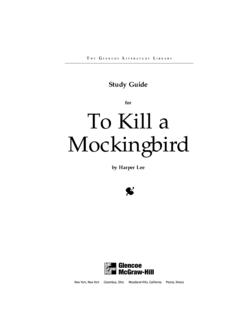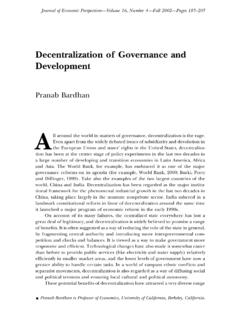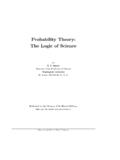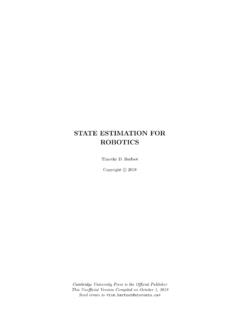Transcription of The Jackknife Estimation Method Avery I. McIntosh
1 The Jackknif e Estimation Method Avery I. McIntosh 1 Introduction Statistical resampling methods have become feasible for parametric Estimation , hypothesis testing, and model validation now that the computer is a ubiquitous tool for statisticians. This essay focuses on the resampling technique for parametric Estimation known as the Jackknife procedure. To outline the usefulness of the Method and its place in the general class of statistical resampling techniques, I will quickly delineate two similar resampling methods : the bootstrap and the permutation test. Other Sampling methods : The Bootstrap The bootstrap is a broad class of usually non-parametric resampling methods for estimating the sampling distribution of an estimator. The Method was described in 1979 by Bradley Efron, and was inspired by the previous success of the Jackknife Imagine that a sample of n independent, identically distributed observations from an unknown distribution have been gathered, and a mean of the sample, Y , has been calculated.
2 To make inferences about the population mean we need to know the variability of the sample mean, which we know from basic statistical theory is V[Y ] = V[Y ]/n. Here, since the distribution is unknown, we do not know the value of V[Y ] = 2 . The central limit theorem (CLT) states that the stan- dardized sample mean converges in distribution to a standard normal Z as the sample size grows large and we can invoke Slutsky's theorem to demonstrate that the sample standard deviation is an adequate estimator for standard deviation when the distribution is unknown. However, for other statistics of interest that do not admit the CLT, and for small sample sizes, the bootstrap is a viable alternative. Briefly, the bootstrap Method specifies that B samples be generated from the data by sampling with replacement from the original sample, with each sample set being of identical size as the original sample (here, n).
3 The larger B is, the closer the set of samples will be to the ideal exact bootstrap sample, which is of the order of an n-dimensional simplex: |Cn | = (2n 1)C(n). The computation of this number, never mind the actual sample, is generally unfeasible for all but the smallest sample sizes (for example a sample size of 12 has about million with-replacement subsamples). Furthermore, the bootstrap follows a multinomial distribution, and the most likely sample is in fact the original sample, hence it is almost certain that there will be random bootstrap samples that are replicates of the original sample. This means that the computation of the exact bootstrap is all but impossible in practice. However, Efron and Tibshirani have argued that in some instances, as few as 25 bootstrap samples can be large enough to form a reliable The next step in the process is to perform the action that derived the initial statistic here the mean: so we sum each bootstrap sample and divide the total by n, and use those quantities to generate an estimate of the variance of Y as follows: B.
4 N1 X o1/2. SE(Y )B = (Y b Y )2. B. b=1. 1. The Jackknif e Estimation Method Avery I. McIntosh The empirical distribution function (EDF) used to generate the bootstrap samples can be shown to be a consistent, unbiased estimator for the actual cumulative distribution function (CDF) from which the samples were drawn, F. In fact, the bootstrap performs well because it has a faster rate . of convergence than the CLT: O(1/n) vs. O(1/ n), as the bootstrap relies on the strong law of large numbers (SLLN), a more robust condition than the CLT. Other Sampling methods : Permutation Permutation testing is done in many arenas, and a classical example is that of permuted y's in a pair of random vectors (X, Y) to get a correlation coefficient p-value. For an observed sample z = {(X1.)}
5 , Xn ), (Y1 , .. , Yn )}, the elements of (only) the Y vector are permuted B times. Then for permutation function ( ), we have that an individual permutation sample zb is: zb = {(X1 , .. , Xn ), (Y (1) , .. , Y (n) )}. The next step is to compute the number of times that the original correlation statistic is in absolute value greater than the chosen percentile threshold (say, and for an empirical level of ), divided by B. This value is the empirical p-value. If B = n! then the test is called exact; if all of the permutations are not performed, then there is an inflated Type I error rate, as we are less likely to sample those values in the tails of the null distribution, and hence we are less likely to say that there are values greater in absolute value than our original statistic.
6 This Method is entirely non-parametric, and is usually approximated by Monte Carlo methods for large sample sizes where the exact permutation generation is computationally impractical. 2 The Jackknife : Introduction and Basic Properties The Jackknife was proposed by Quenouille in 1949 and later refined and given its current name by John Tukey in 1956. Quenouille originally developed the Method as a procedure for correcting bias. Later, Tukey described its use in constructing confidence limits for a large class of estimators. It is similar to the bootstrap in that it involves resampling, but instead of sampling with replacement, the Method samples without replacement. Many situations arise where it is impractical or even impossible to calculate good estimators or find those estimators' standard errors.
7 The situation may be one where there is no theoretical basis to fall back on, or it may be that in estimating the variance of a difficult function of a statistic, say g(X) for some function with no closed-form integral, making use of the usual route of esti- mation the delta Method theorem is impossible. In these situations the Jackknife Method can be used to derive an estimate of bias and standard error. Keith Knight has noted, in his book M athematical Statistics, that the Jackknife estimate of the standard error is roughly equivalent 2. The Jackknif e Estimation Method Avery I. McIntosh to the delta Method for large Def inition: The delete-1 Jackknife Samples are selected by taking the original data vector and deleting one observation from the set.
8 Thus, there are n unique Jackknife samples, and the ith Jackknife sample vector is defined as: X[i] = {X1 , X2 , .. , Xi 1 , Xi+1 , .. , Xn 1 , Xn }. This procedure is generalizable to k deletions, which is discussed further below. The ith Jackknife Replicate is defined as the value of the estimator s( ) evaluated at the ith Jackknife sample. (i) := s(X[i] ). The Jackknife Standard Error is defined n nn 1 X o1/2. jack =. SE( ) ( (i) ( ) )2 , n i=1. where ( ) is the empirical average of the Jackknife replicates: n 1 X . ( ) = (i). n i=1. The (n 1)/n factor in the formula above looks similar to the formula for the standard error of the sample mean, except that there is a quantity (n 1) included in the numerator. As motivation for this estimator, I consider the case that does not actually need any resampling methods : that of the sample mean.
9 Here, the Jackknife estimator above is an unbiased estimator of the variance of the sample mean. To demonstrate this claim, I need to show that n n n 1X 1 X. ( (i) ( ) )2 = )2. (xi x n n(n 1). i=1 i=1. I note that here the Jackknife replicates in the inner squared term on the left simplify as follows: n n x xi n 1X 1 1X 1. ( (i) ( ) ) = x (i) = x xi . n x xi =. n x xi ). ( . n 1 n n 1 n n 1. i=1 i=1. Once the term is squared, the equation is complete, and is identically equal to the right hand term above. Thus, in the case of the sample mean, the Jackknife estimate of the standard error reduces 3. The Jackknif e Estimation Method Avery I. McIntosh to the regular, unbiased estimator commonly used. The standard error estimate is somewhat ad hoc, but it is also intuitive.
10 A more formal derivation was provided by Tukey and involves pseudovalues, which are discussed briefly below. It has been shown, however, that the Jackknife estimate of variance is slightly biased upward,4 and does not work in all situations, for example, as an estimator of the median (see Knight, ibid.). In instances such as quantile Estimation , it has been . shown that the delete d Jackknife , where n < d < (n 1), is a consistent The delete-d variance estimator has similar form as the delete-1 estimator, with a different normalizing constant: ( )1/2. d jack = n d X. SE( ) ( (z) ( ) )2. n z d d The Jackknife Bias is defined as d jack = (n 1)( ( ) ), bias . where is the estimator taking the entire sample as argument. Jackknife Bias is just the average of the deviations of the replicates, which are sometimes called Jackknif e Inf luence V alues, mul- tiplied by a factor (n 1).
















